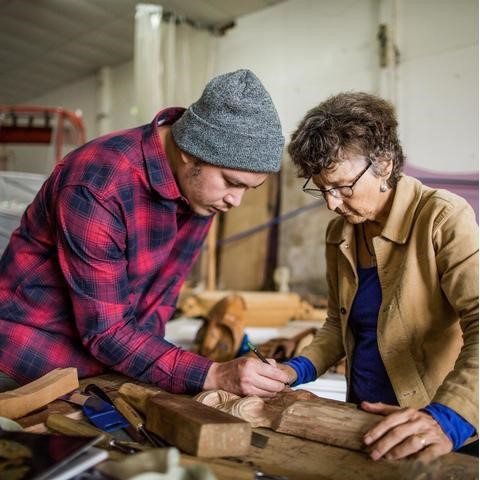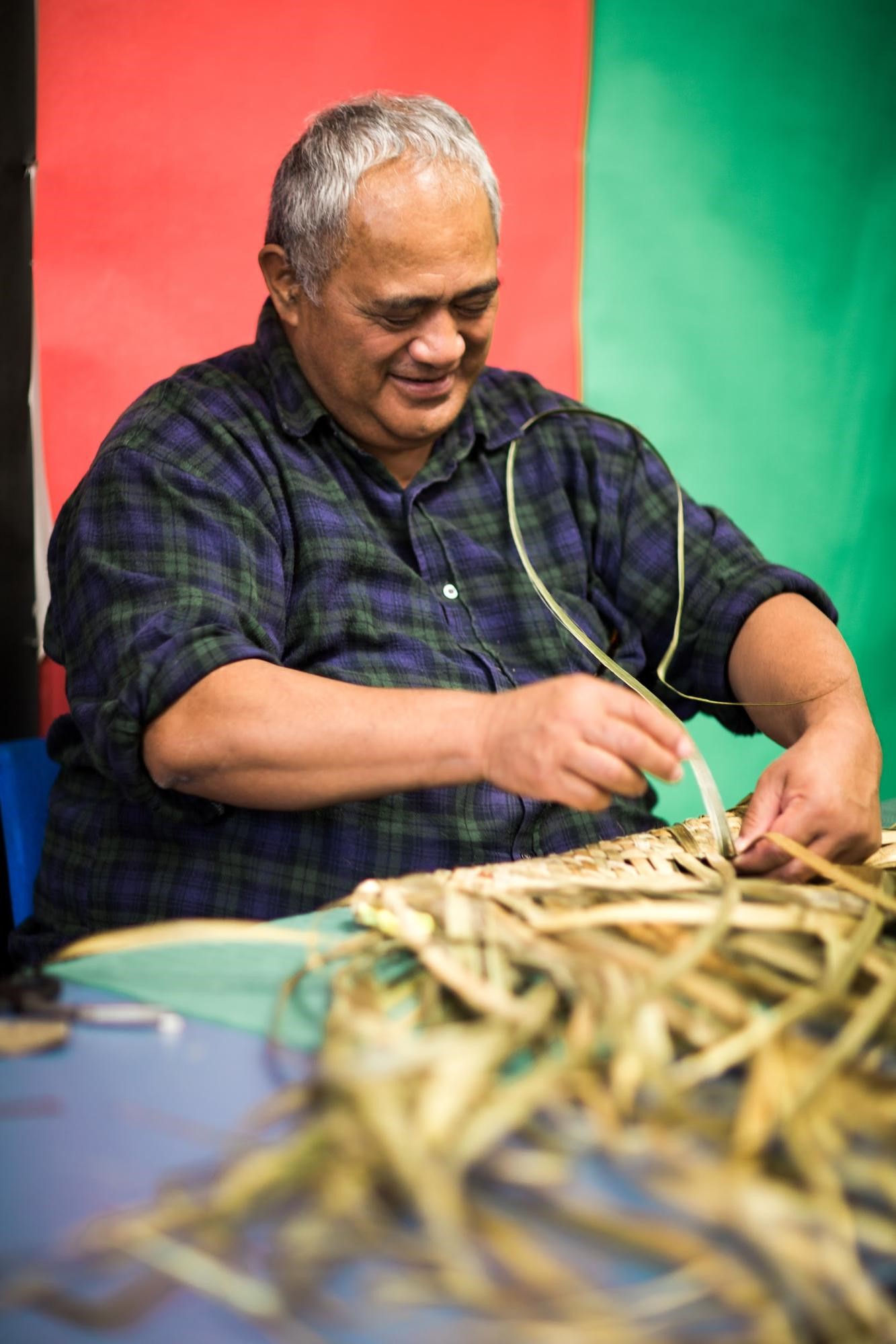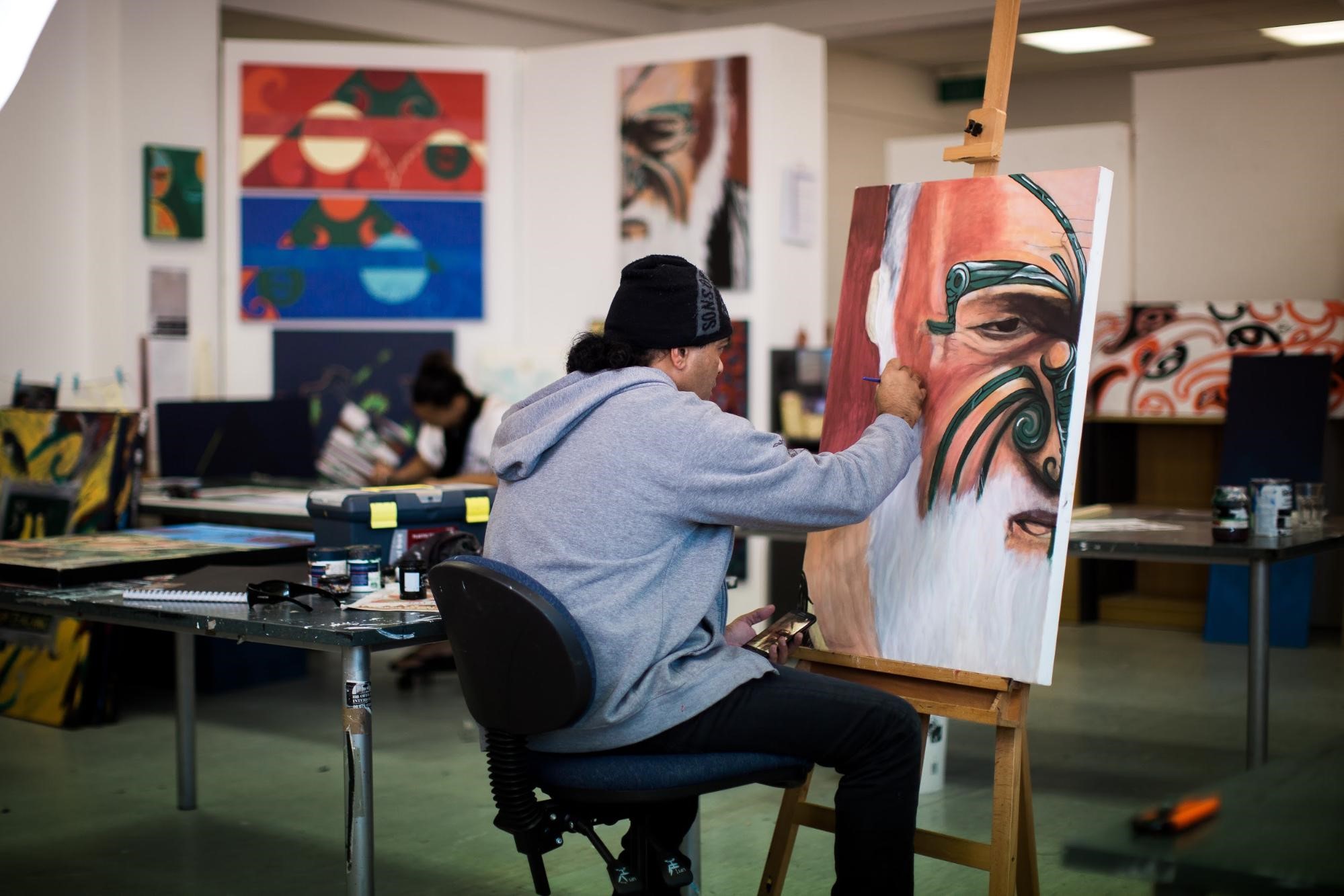Built on Toi

The next wave of Māori artists are part of an evolution that is grounded in the revolutionary beginnings of Te Wānanga o Aotearoa.
The right education can change an individual’s path. But in the case of Te Wānanga o Aotearoa, the right education has been a gateway to changing the face of tertiary learning in this country.
In an era of unprecedented appreciation of te ao Māori by the wider public - be it enhanced use and teaching of te reo or ‘mainstream’ championing of Māori culture - Te Wānanga o Aotearoa is at the forefront of breaking down those barriers. From its inception in 1983, toi Māori (Māori art) has been the heartbeat of that success.
The Foundation to success
Kim Marsh, who has been Kairuruku Toi Rauangi, the co-ordinator of the Māori Visual Arts programme at Te Wānanga o Aotearoa for the past 13 years, points out while the Toi programmes may be considered niche compared to others inside the organisation, they are quite literally a cornerstone.
“We are actually what designates a Wānanga - in order to be a Wānanga, you have to teach both te reo Māori and toi,” Marsh says, acknowledging the role traditional Māori artforms played in establishing Te Wānanga o Aotearoa.
Keeping Things Contemporary
But just as the world has evolved, so have the teaching techniques and appetite of the students. “Men can study raranga (weaving), women can study whakairo (carving), we’re here to teach people and give them the experience.
Marsh adds “There’s a real growth in digital media in the contemporary arts which is an awesome place for tauira (students) to start expressing themselves. Most people have a few digital skills these days through phones and computers.
“We’re definitely spreading our wings, which is really great.”
Men can study raranga (weaving), women can study whakairo (carving), we’re here to teach people and give them the experience
Know Your Roots
Such studies would have seemed light-years away in 1980s Te Awamutu, when Rongo Wetere and Kohuru Rokopa “Boy” Mangu decided to do something about what they saw as an education system failing Māori students. So they began to train Māori youth in the ways of their tūpuna (ancestors) by giving them a purpose - building Otāwhao Marae, on the grounds of Te Awamutu College.
Kereti Rautangata, the Kairuruku of Mau Rākau (Māori weaponry) and Whakairo (carving) at Te Wānanga o Aotearoa was part of that experience. He recounts “Rongo Wetere and Boy Mangu wanted to teach our young people who they are culturally, so they don’t wander the streets mindlessly and listlessly.”
Learning the ancestral skills of whakairo (carving) and raranga (weaving) was so empowering, it became transformative. “That momentum was so positive, and it kept on going. Rongo picked it up and ran with it,” says Rautangata.

The art of weaving among many taught at Te Wānanga o Aotearoa.
Know your Future
It was those formative decisions that not only lead to the creation of Te Wānanga o Aotearoa but sculpt its future success. “The roots of the Wānanga are in toi, we try as hard as we can to maintain all of that,” Marsh explains. “Our heritage, our link to the tradition, as well as the way in which we move forward. Keeping our values in mind, keeping whānau, hapū, iwi in mind, what’s good for Māori art and our tauira (students) in relation to all of those things.”
The roots of the Wānanga are in toi, we try as hard as we can to maintain all of that
A self-described first generation New Zealander, Marsh’s love for Māori language and customs developed over her time in Whaingaroa (Raglan). “There are a lot of people like myself who connect really easily with Māori ideology and Māori values, we get artists from all walks (of life) who want to come study with us.
“We’ve had a really successful graduate recently who’s German, she’s been in NZ for 20 years and she’s really great at kōwhaiwai, Marsh says. “We’ve had other graduates who are pākeha and from all across the indigenous, Pasifika spectrum.”
Strength in Numbers
Much of that attraction comes from the variety Te Wānanga o Aotearoa offers. Over 30,000 tauira are delivered certificate, diploma, undergraduate bachelor and masters level programmes across all courses each year - with toi Māori, that includes five main strands - Whakairo (carving), Mau Rākau (Māori martial arts), Toi Ataata/Rauangi (visual arts) and Māori Performing Arts & Raranga/Te Mahi Te Whare Pora (weaving).
But Marsh says what they pride themselves on is their reach and connection to communities throughout the country. “What makes us different is we teach in a lot of places. While other institutions are all single site, we have sites all over the country. For example, in a small town like Ōpōtiki, we’re now delivering toi programmes with a focus on digital media.”
It’s that spread - more than 120 locations throughout Aotearoa - that helps Te Wānanga o Aotearoa stick true to its founding principles. “We try whenever possible to enable our students to be able to learn close to home,” explains Marsh, “because we feel that’s easier. There’s less financial stress on the tauira, it makes it easier for them to get to class and therefore have success.”
 A student working on his mahi toi at Te Wānanga o Aotearoa.
A student working on his mahi toi at Te Wānanga o Aotearoa.
Local Knowledge
Marsh points out that also means they’re learning from local people - probably from their own hapū or iwi - so knowledge specific to their whenua (land) is passed on, while the tauira’s own learning is shared “not just back to their teachers but to the teachers of their teachers. Māori arts is a very collective experience.”
Māori arts is a very collective experience
“For us, when we look at the (arts) industry, we see it differently. To a certain degree, we see our industry and where our tauira will end up is with their own iwi - and what they can do in their own communities and for their own people.”
As the window for new enrolments for the first intake of 2020 begins to close, Marsh encourages anyone with an interest in toi Māori to take that step. It’s one that few would regret, with Te Wānanga o Aotearoa boasting one of the highest rates of student success amongst NZ tertiary providers, and 96% of our students recommend us as their preferred place of learning.
“You’re not just an anonymous face in a room. Some of our tauira need a little bit more help, some of them haven’t studied in a while. We’re understanding around whānau needs as well.
“What I see from our classes is I see very committed kaiako, teachers that are willing to go the extra mile, it’s a real one to one experience, it’s quite personal,” Marsh exudes.
“The programmes we have to offer are as good as any of the main institutions. But I think what makes us special is the atmosphere that we provide - it’s very Māori-centric.”
Written in partnership with Te Wānanga o Aotearoa. Find out more about studying Māori and Indigenous Arts here.
Source: The Big Idea
